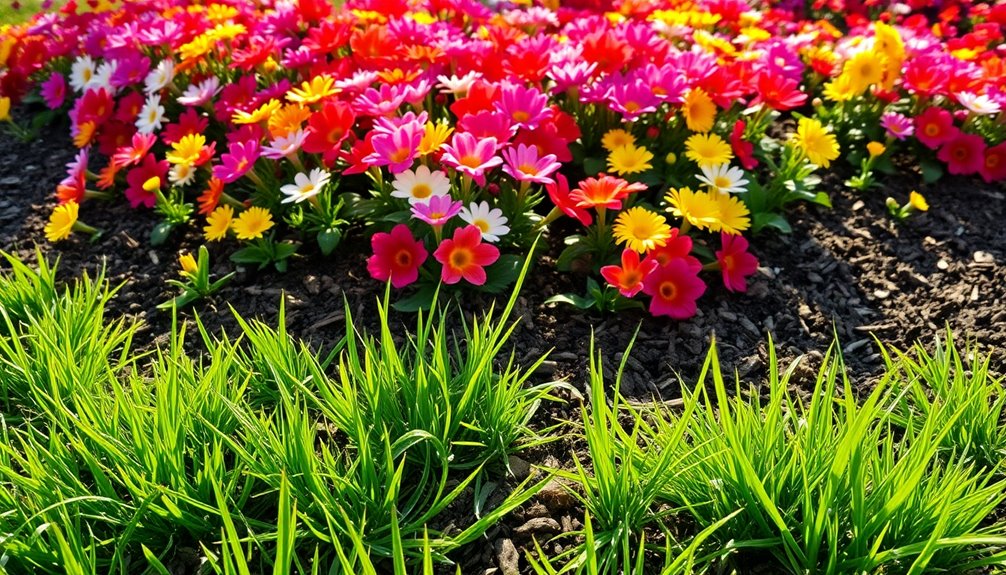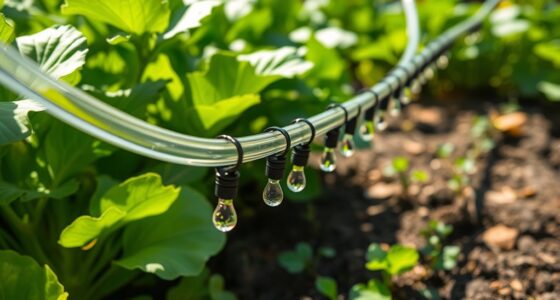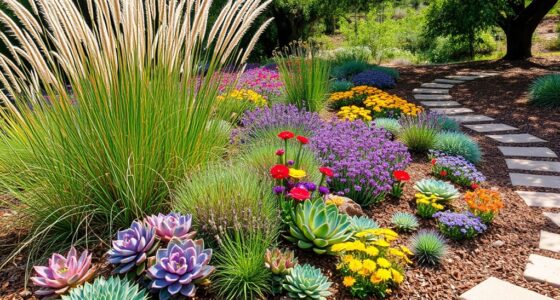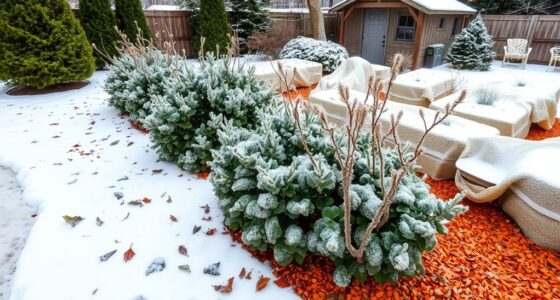To keep your flower beds weed-free, start by understanding the grass competition for sunlight and nutrients. Manual removal works well for small patches, especially in moist soil. You can also use a natural weed killer made from vinegar, salt, and dish soap. Consider solarization by covering grass with clear plastic to generate heat, or edging your beds to create a barrier. Regularly monitor for new grass growth to address it quickly. When faced with tough infestations, professional help might save you time. Discover more effective techniques to guarantee your garden thrives and stays beautiful.
Key Takeaways
- Remove grass manually during moist soil conditions for effective uprooting, especially in small patches.
- Use a natural weed killer made of vinegar, salt, and dish soap for eco-friendly grass control.
- Implement solarization by covering grass with clear plastic to generate heat and kill it.
- Establish garden edging to create a barrier that prevents grass from invading flower beds.
- Apply organic mulch (2-3 inches) to suppress grass growth while enriching the soil for flowers.
Understanding the Grass Problem
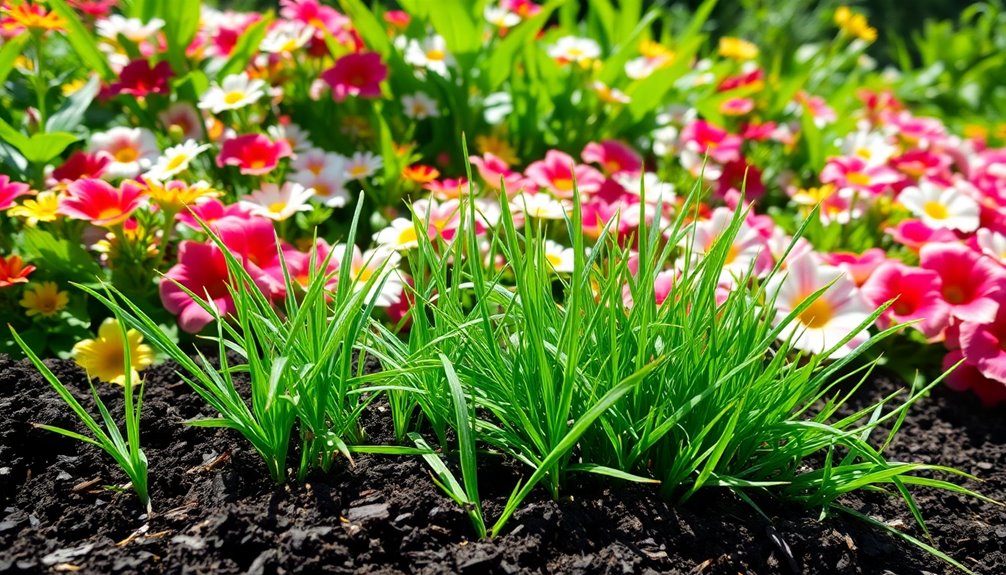
When you notice grass creeping into your flower beds, it's not just an aesthetic issue; it's a sign that your plants are competing for crucial resources.
Grass competes with your flowers for essential sunlight, water, and nutrients, ultimately leading to diminished health and vitality. Weeds like crabgrass can spread rapidly, developing deep root systems that make removal a challenge.
Their presence often indicates poor soil management, which can detract from your garden's beauty. If left unchecked, these weeds can dominate your flower beds, hindering the growth of the plants you cherish.
To guarantee your flowering plants thrive, you need to address the grass and weeds, safeguarding their access to the nitrogen, phosphorus, and potassium they require.
Timing and Preparation

To effectively tackle grass in your flower beds, timing and preparation are essential elements that can markedly enhance your efforts. The best time to remove grass is in the spring for annual weeds and in the fall for perennial ones, ensuring maximum effectiveness.
Before you apply any herbicides, trim back surrounding plants to reach the grass at its base for targeted treatment. Choose a day with slightly moist soil, as this will improve the efficiency of both grassroots removal and herbicide application.
Always wear protective gear, like gloves and masks, when handling herbicides to prevent skin irritation and inhalation.
Finally, conducting a soil test can help identify any nutrient deficiencies contributing to grass competition in your flower beds.
Grass Removal Techniques

With proper timing and preparation in place, you can effectively employ various grass removal techniques to maintain your flower beds.
For small patches of grass, manual removal is ideal, especially when the soil is moist, making it easier to extract roots.
If you prefer a natural approach, try using a mixture of 1 gallon of white vinegar, 1 cup of salt, and 1 tablespoon of dish soap as a weed killer.
Additionally, consider solarization by covering the grass with clear plastic to create a hot environment that kills grass over time.
If you need a more targeted solution, selective herbicides can help you eliminate specific grass types while protecting your flowers.
It's also important to remember that open communication with other gardeners can provide valuable tips and experiences in weed management.
Alternative Control Methods
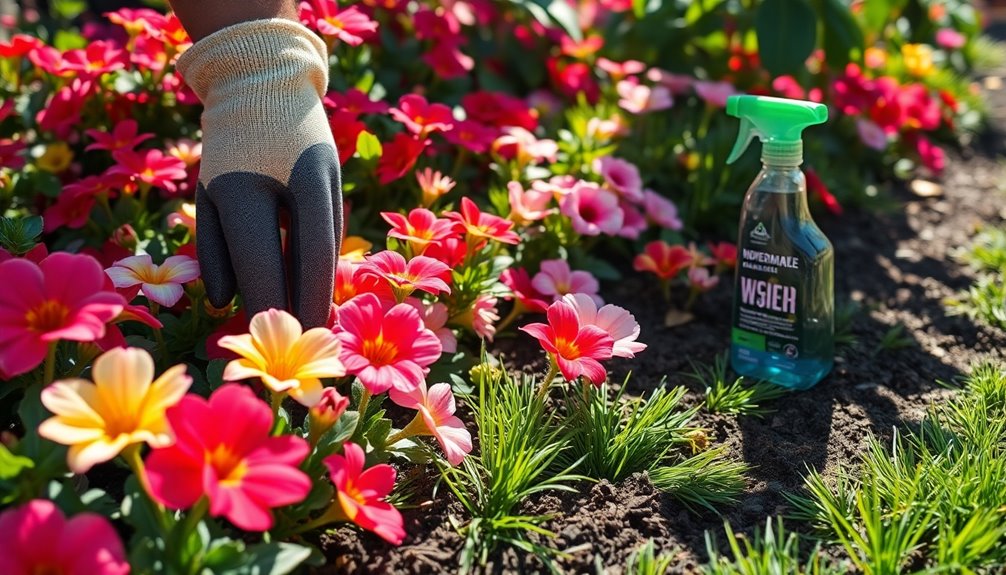
While you might be familiar with traditional grass removal methods, exploring alternative control techniques can enhance your flower bed maintenance.
These methods not only help you kill the grass but also promote a healthier garden environment. Here are some effective strategies:
- Solarization: Cover grass with clear plastic to trap heat and effectively kill it.
- Sheet Mulching: Use layers of cardboard or newspaper topped with organic materials to smother grass.
- Selective Herbicides: Target specific grass species while protecting your flowers.
- Regular Monitoring: Catch new grass growth early to remove the grass before it establishes dominance.
- Garden Edging: Create a physical barrier that acts as a weed prevent-er, reducing grass competition.
Edging and Mulching Benefits
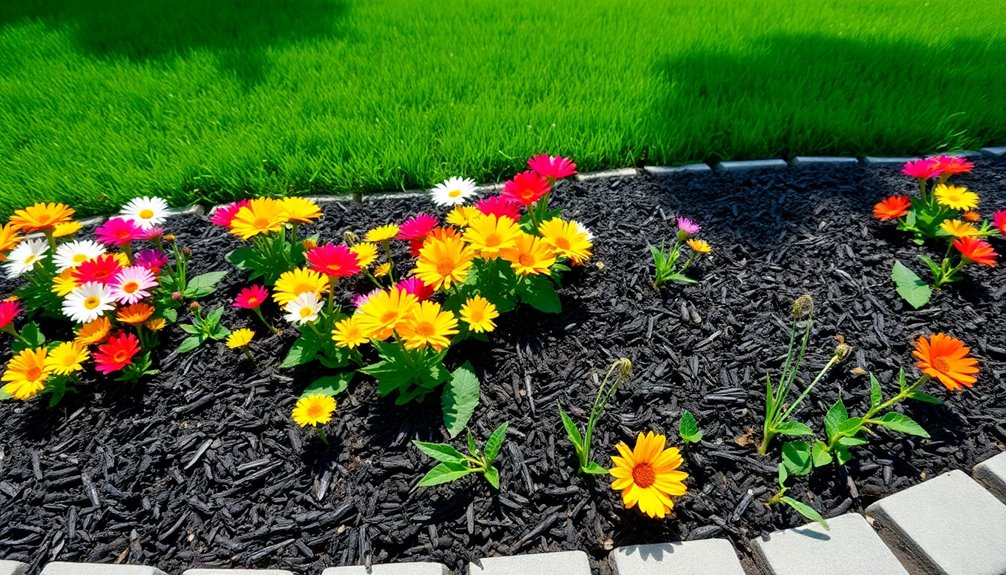
Creating a well-defined boundary between your flower beds and surrounding grass can greatly enhance your garden's health and aesthetics. Edging forms a physical barrier that keeps grass and weeds at bay, reducing competition for essential resources like sun and water. This means your flowers can thrive without the stress of encroaching vegetation.
Regular maintenance of your edging is crucial to guarantee its effectiveness over time. Additionally, applying a 2-3 inch layer of organic mulch serves a dual purpose: it suppresses weed growth and regulates soil temperature and moisture. As the mulch decomposes, it enriches the soil, further benefiting your flowers. Combining proper edging with mulch creates a beautiful and healthy environment for your garden to flourish. Moreover, using weather-resistant materials in your edging can ensure durability and longevity in your garden setup.
DIY vs. Professional Help

Maintaining a beautiful flower bed often leads to the question of whether to tackle grass removal yourself or hire a professional. While DIY projects can be rewarding and cost-effective, they can also be time-consuming and labor-intensive. Conversely, a professional may ensure a quicker and more effective grass removal, allowing you to focus on other aspects of your garden, like selecting the best gravel types for driveways that complement the aesthetics of your flower bed. Ultimately, weighing the pros and cons of each option will help you make an informed decision that suits your gardening goals.
If you're handy and the grass invasion is manageable, DIY methods like manual pulling or using vinegar solutions can save you money.
However, for tougher infestations, professional landscaping services might be your best bet.
- Access to specialized tools and herbicides
- Tailored solutions for specific grass types
- Expertise in lawn care and weed management
- Time-saving convenience for busy homeowners
- Peace of mind knowing it's done right
Additionally, professionals often utilize specialized tools and herbicides that can effectively target unwanted grasses without harming your flowers.
Assess your skills and the extent of the problem to decide.
Ultimately, the right choice can lead to a thriving garden that flourishes without unwanted grass.
Frequently Asked Questions
How to Stop Grass From Growing in a Flower Bed?
To stop grass from growing in your flower bed, start by regularly removing it by hand, making sure to pull out the roots.
You can also set up garden edging to create a barrier that keeps grass away.
Applying a thick layer of organic mulch around your flowers will help suppress grass growth.
If you want to be proactive, consider using pre-emergent herbicides or solarization to eliminate existing grass and prevent future growth.
What to Use in Flower Beds to Keep Weeds Out?
To keep weeds out of your flower beds, consider using organic mulch. Applying a 2-3 inch layer not only blocks sunlight but also retains moisture.
You can also use pre-emergent herbicides like Preen to stop weed seeds from germinating. Installing garden edging creates a physical barrier against weeds, while regularly checking for new growth lets you remove small infestations quickly.
Techniques like sheet mulching can smother weeds and enrich your soil.
Can You Spray Grass Killer in Flower Beds?
Yes, you can spray grass killer in flower beds, but you've got to be careful.
Use a targeted spray to avoid harming your flowers. Non-selective herbicides will kill everything, so consider selective options that only target grass.
Timing's essential; apply it when grass is actively growing for the best results.
Always follow the manufacturer's instructions to guarantee you control the grass effectively while keeping your flower garden safe and thriving.
How Do You Make a Flower Bed Without Digging up Grass?
To make a flower bed without digging up grass, try the sheet mulching technique.
Start by laying down cardboard or newspaper over the grass, ensuring it's wet and free of tape or labels.
Then, cover it with a thick layer of organic mulch like wood chips or straw.
This method smothers the grass while enriching the soil as the materials decompose.
Finally, cut holes for your flowers to thrive.
Conclusion
To sum up, keeping your flower beds grass-free is essential for a thriving garden. Did you know that over 50% of gardeners struggle with unwanted grass? By understanding the problem, timing your actions, and employing effective removal techniques, you can reclaim your flower beds. Don't forget the benefits of edging and mulching, which not only enhance your garden's appearance but also prevent future grass growth. Whether you choose DIY methods or hire professionals, a weed-free garden is within your reach!
